The Tabriz Grand Bazaar is one of the largest covered bazaars in the world and is among the most vibrant historical markets in Iran. It has been registered on the Iran’s UNESCO World Heritage List. This bazaar, comprising various social structures, is unique among Iranian markets.
The Labyrinth of Tabriz Grand Bazaar
With its numerous and intricate alleyways carrying years of history and memories, the bazaar’s old brick walls, brown wooden doors, friendly people, traditional texture, and long history attract many tourists to Tabriz each year. Here, you can enjoy walking and admiring the charming architecture while purchasing top-quality goods like leather products, fabrics, handwoven carpets, nuts, handicrafts, and more at reasonable prices. To get acquainted with the largest registered world heritage site in Iran, don’t miss this article.

Introduction to Tabriz Grand Bazaar
The covered bazaar of Tabriz, spanning over one square kilometer, is the largest contiguous brick structure in the world, consisting of 5,500 shops, 20 rows, 25 caravanserais, and 35 other structures including schools, baths, mosques, and caravanserais. It shines like a gem among Iranian bazaars, with all its parts interconnected.
Functionality of Tabriz Grand Bazaar
The functions of the Tabriz Bazaar include collection, distribution, and retail. Various goods are sold here, with the most important being handwoven carpets, leather bags and shoes, herbal and medicinal products, spices, fabrics, etc. It retains the atmosphere of traditional markets without modern gadgets like mobile phones or computers.
History of Tabriz Bazaar
The exact age of the Tabriz Grand Bazaar is unclear. However, numerous travelers from Ibn Battuta and Marco Polo to Yaqut Hamawi, Gaspar Drouville, Jean Chardin, Jemla Kardi, Hamdallah Mustawfi, and others, from the 4th century AH to the Qajar era, have praised the bazaar and provided information about it. Since Tabriz was on the Silk Road, it enjoyed great prosperity and was one of the most important trading centers of its time, with its bazaar gates serving as the city’s main gates.
The current bazaar dates back to the late Zand and Qajar periods. There are paintings from the Seljuk period suggesting a bazaar at the current site of Tabriz Grand Bazaar. With Tabriz chosen as the capital during the Ilkhanate era, the bazaar gained fame, a trend that continued into the Safavid era. As we mentioned, the Tabriz Grand Bazaar has undergone various events such as destructive earthquakes (the 1193 AH earthquake) and has been rebuilt each time. In fact, the current bazaar dates back to the late Zand and Qajar periods.
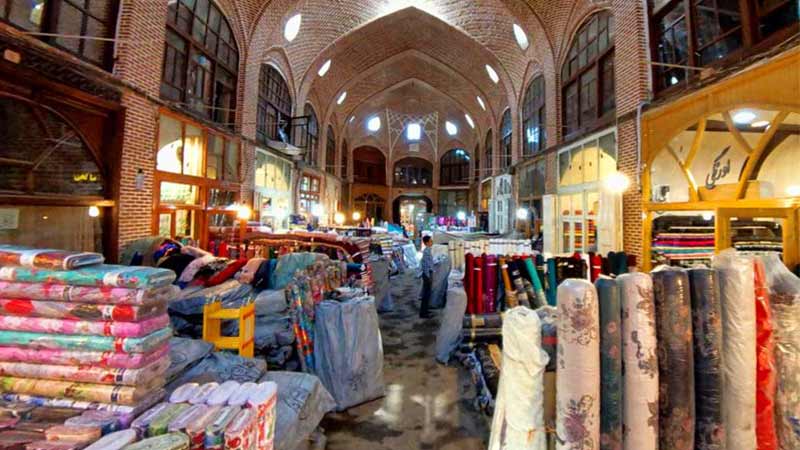
During the Qajar era, when Tabriz was near European markets and served as the crown prince’s city, the bazaar maintained its prosperity and continued to be the main export route from Iran to Europe. In the 13th century, coinciding with the era of Abbas Mirza, the Qajar crown prince, it became a famous commercial center where English traders arrived via the Silk Road. The volume of trade at that time was such that about 30% of Iran’s trade took place in the Tabriz Bazaar. During Abbas Mirza’s regency, alongside the construction of his palace complex known as Ali Qapu on the east side of the bazaar, many caravanserais and timchehs were built.
Moreover, the presence of historical mosques and schools such as the Grand Mosque, Sadeghieh School, and Haj Safar Ali School affirms the historical background of this complex.
From mirrors and various fabrics to glass, sugar, metal, sugar candy, etc., most of the Europeans’ imports to Iran were made up of these items. Goods such as silk, tobacco, dried fruits, shawls, mazoo, and wax were also sold to Europeans in this bazaar.
Architecture of Tabriz Bazaar
The Tabriz Grand Bazaar is constructed in such a way that its exterior is in harmony with the urban fabric and resembles ordinary buildings. Moreover, the significance of the Tabriz Bazaar is not only due to its size but also in terms of the architects’ mastery in using bricks and terracotta, creating diverse spaces. One of the interesting features of this bazaar is the vents in the center of its arches, which facilitate the escape of hot air; while in some parts of the bazaar, no vents are installed to prevent drafts. The thick walls of this structure also help maintain heat in winter.
Timchehs
The timchehs of the bazaar are dedicated to selling a specific item, and their goods are more expensive. For instance, separate spaces have been designated for cobblers, fabric sellers, chinaware sellers, fruit sellers, hat makers, coppersmiths, carders, etc. The Muzaffariyah Timcheh specializes in precious carpets, the Amir Timcheh in gold and jewelry, and the Kalaahdoozan Timcheh in Azerbaijani wool hats. Despite similarities in terms of the number of sides and framing, the construction pattern of these timchehs varies. For example, timchehs with a longitudinal form have scattered light inlets, creating a rhythm of light and darkness. The timchehs have domed, brickwork roofs, and their entrance doors are open during the day and closed at night and on holidays.
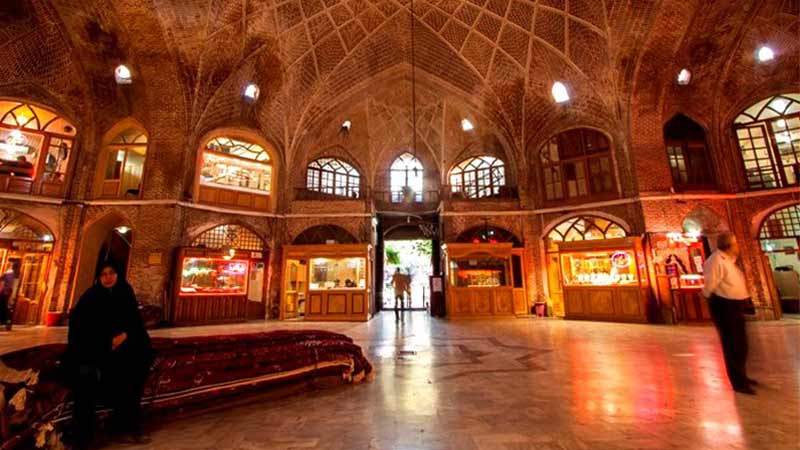
Most caravanserais and timchehs are built on three levels: the lower level for storage or warehouse, the second level as a workplace and trading house, and the third level for rest.
Rows
The main rows are connected by subsidiary rows, between which timchehs and caravanserais are built. At the intersection of rows, there are three- and four-way intersections decorated with domed brick arches. The rows of the bazaar are covered public passages without entrance doors. The main rows of the Tabriz Bazaar include the Old Bazaar Row, Cobblers’ Bazaar, Safi Bazaar, Jom’eh Mosque Bazaar, Yemeni Sewing Bazaar, Abu al-Hasan Bazaar, Big and Small Dalan Zan Bazaar, etc.
Given the rainfall and cold weather in Tabriz, the rows of the bazaar are covered. Moreover, the height of their roofs reaches five to six meters, shorter than the bazaars in Iran’s warm regions, to retain heat. When walking in this bazaar, you will see that the rows are about four to five meters wide and are oriented north-south.
Caravanserais
There are several caravanserais in the Tabriz Grand Bazaar, from the Amir Grand Caravanserai to the Haj Abu al-Hasan Caravanserai and the Haj Mirza Mohammad Caravanserai, which were bustling in their time. These structures include a courtyard for unloading goods and animals, rooms, shops, and warehouses. The courtyards of the caravanserais served as breathing spaces for the bazaar, with vents above the bazaar’s dome bringing in oxygen and fresh air.
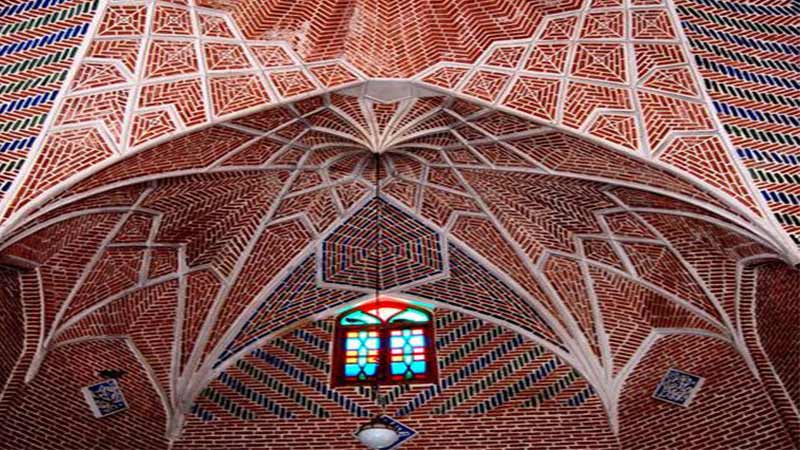
Courtyards
The Tabriz Bazaar is home to notable and famous courtyards like the Gorji-Lar, Mirza Mehdi, Khan, Haj Mohammad Gholi, Amir, Omid, and Koochechi-Lar courtyards. These consist of small units with open courtyards, where goods were unloaded in the past.
Passageways
The passageways of the Tabriz Bazaar, connect caravanserais, inns, and commercial complexes to the main market. Often, their names are derived from the commercial complexes and caravanserais they lead to.
Schools and Mosques
In addition to 12 religious schools, the Tabriz Bazaar also has about 30 historical mosques like the Jameh Mosque, Hojatoleslam Mosque, Mofid Agha Mosque, and Mausoleum Mosque. These are adorned with stone columns, ribbed domes, and intricate muqarnas.
Bathhouses
The Khan, Qazi, Mirza Mehdi, and Nobar Bathhouses are among the bathhouses in the Tabriz Bazaar. They are significant for their architecture and historical value.
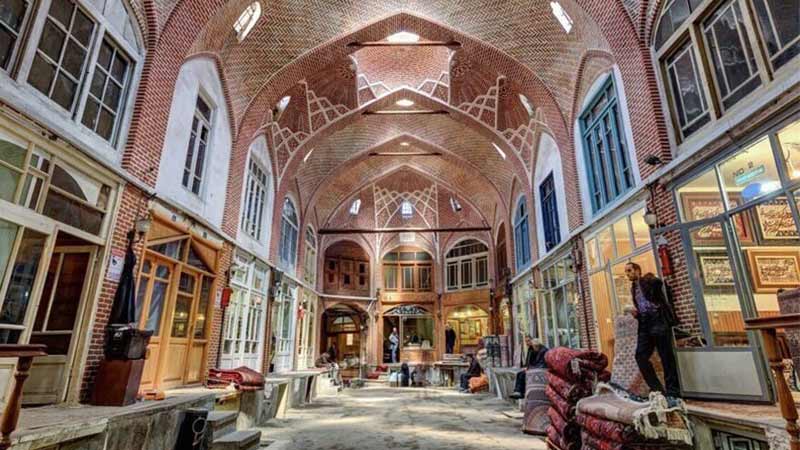
Famous Sections of the Tabriz Bazaar
The historical complex of the Tabriz Grand Bazaar consists of various sections like stalls, inns, commercial complexes, passageways, markets, squares, market rows, crossroads, mini-markets, gates, mosques, libraries, market bridges, shrines, schools, traditional gyms, bathhouses, museums, houses, and more.
Amir Market, Commercial Complex, and Amir Caravanserai
The Amir Market, dedicated to gold and jewelry, is one of the most beautiful and busiest sections of the Tabriz Grand Bazaar, popular among both shoppers and tourists. It houses around 112 shops, most selling jewelry, with some offering fabrics, perfumes, and cosmetics. Mirza Mohammad Khan Amir Nezam, during the crown prince era of Abbas Mirza Nayeb al-Saltaneh, constructed this market.
The Amir Commercial Complex, dating back to the Qajar period and located at the beginning of the Tabriz Bazaar, is one of the most magnificent complexes in the market, renowned for its extraordinary architecture. It specializes in gold and jewelry sales. This octagonal structure features beautiful decorations and muqarnas arches and houses the largest brick dome in the Tabriz Bazaar. The complex’s shops are spread over two floors.
The Amir Caravanserai is the largest in the Tabriz Bazaar, with a vast rectangular courtyard spanning 3,350 square meters. It has symmetrically designed shops on two levels around the courtyard and features two perpendicular, symmetrical axes.
Mozaffariye Commercial Complex
The Mozaffariye Commercial Complex is among the most famous historical complexes in the Tabriz Grand Bazaar, dating back to 1305 AH during the crown prince era of Mozaffar al-Din Shah Qajar. It is a prime center for selling and repairing handmade carpets and rugs in Tabriz and East Azerbaijan Province.
This complex is named after Mozaffar al-Din Shah, who praised it during a visit, following the custom of declaring such properties as gifts to the crown prince. To avoid this, Haj Sheikh Jafar Qazvini, the founder, named it Mozaffariye, pleasing the crown prince, who granted him special privileges, ensuring Sheikh retained ownership.
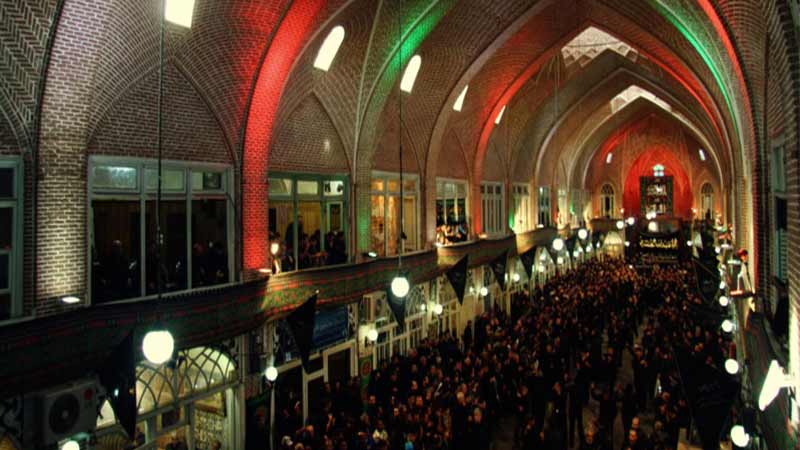
Despite changes over time, the Mozaffariye Complex’s original essence has been preserved. For instance, the internal space of the shops was expanded, while the nature of the porticos changed. A corridor-like passageway with a vaulted ceiling was built behind the shops to provide a connecting route.
Sa’adat Abad Market Row
The Sa’adat Abad Market Row, parallel to the New Market Row, starts from the Sa’adat Abad Crossroads and extends to the Sa’adat Abad Commercial Complex. Key parts of this route include the Sa’adat Abad Mosque, Mirza Jalil Passage, Hat Makers Market, Malek Commercial Complex, Haj Hossein Awwal Inn, and the Bloody Passage.
Market Row
The Market Row, also known as the National Market, has numerous complexes and caravanserais for selling a variety of goods. It is one of the largest mini-markets in Tabriz.
Sheikh Kazem Commercial Complex
The Sheikh Kazem Commercial Complex, consisting of a large complex, a small complex, and a small caravanserai, is located at the intersection of the Shoemakers’ Row and the New Market Row. Most shops here sell women’s and children’s clothing, although some belong to the Towel Makers’ Guild. One of the most attractive features of this complex is its vaulted architecture, harmoniously integrated with its geometry, making it one of the finest examples of Tabriz Bazaar’s architectural style.
Jameh Mosque of Tabriz
The Jameh Mosque of Tabriz, a historical building, dates back from the Seljuk to the Qajar period. Registered as a national monument of Iran in 1310, it is located on the southern side of the Talebiye School at the end of the Tabriz Grand Bazaar. Initially, the mosque had one portico, later expanded to two. Its construction was inspired by the exclusive Firuzabad Palace. The current mosque was built by the governor of Tabriz after surviving the 1193 AH earthquake, marking it as an important Qajar era monument.
Shoemakers’ Market (Bashmaqchi)
The Shoemakers’ Market is a primary location for producing and selling shoes, especially handmade ones, in Tabriz. It includes various sections like the Omid Complex and Caravanserai, and the Haj Abolghasem Complex and Caravanserai.
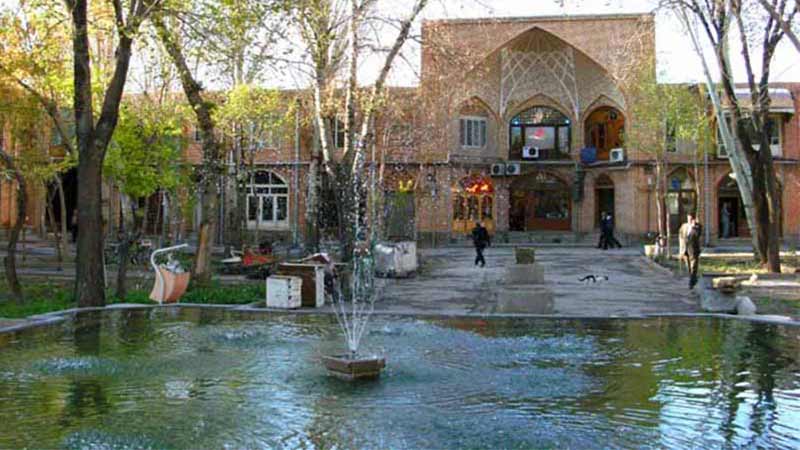
Crystal Sellers’ Market
The Crystal Sellers’ Market, known for selling crystal and glassware in Tabriz, consists of various sections like the Sugar Sellers’ Commercial Complex, Mozaffariye Commercial Complex, Mirza Mohammad Passage, Mirza Mohammad Caravanserai, Bamchi Passage, Haj Sheikh Passage, and Gorji Caravanserai.
Garshasp Wrestling House
The Garshasp Wrestling House, one of the intriguing buildings in the Tabriz Grand Bazaar and the city’s oldest traditional gym, has launched many wrestlers and strongmen. After several years of renovation and restoration, it now operates as the Darbar Traditional Restaurant, hosting tourists.
Khan Bathhouse
The Khan Bathhouse, dating back to the Qajar period, is one of the oldest historical bathhouses in Tabriz. Adorned with brick arches and stone columns, it has a beautiful garden in the exterior area, enhancing the charm of this Qajar-era bathhouse.
Haj Ali Restaurant
Located in the Hat Makers Market (Bohechi Bazaar), the Haj Ali Restaurant is a nostalgic and famous part of the Tabriz Grand Bazaar, becoming an integral part of the market’s identity. Its delicious kebabs, from Barg to Chenjeh, Kubideh, and Chelo Kabab Gholo, served in an old and cozy atmosphere with the inviting aroma of rice and butter, are appealing to any tourist. Haj Ali passed away years ago, and now his son manages the restaurant.
Renovations of Tabriz Bazaar
Tabriz Grand Bazaar has survived numerous historical events, including the 1193 Hijri Qamari earthquake that caused significant damage. However, it was restored by Najafqoli Khan Donboli, the governor of Tabriz at the time.
A massive flood in 1288 Hijri Qamari destroyed much of the city and various sections of the bazaar. The son of Haj Mirza Ali Akbar Qavam al-Molk Shirazi, with the help of merchants and a 10,000-toman donation from Mozaffar al-Din Mirza, the crown prince, built a dam on the Mehran River.
In 1398 Hijri Shamsi, a major fire broke out, damaging parts of the bazaar. Tabriz Bazaar had been prone to fires, leading to a decision to replace most of the wooden ceilings with domes for safety.
Attractions Around Tabriz Bazaar
Tomb of the Poets: This cultural landmark in Tabriz houses the graves of over 400 famous poets, including Ustad Shahriar, Khaghani, Asadi Tusi, and Lesani Shirazi. Located in a historic neighborhood, it’s about three kilometers from the Tabriz Grand Bazaar.
Blue Mosque: Known for its unique lapis lazuli tilework, this mosque is often referred to as the “Turquoise of the Islamic World”. It’s the only surviving building from the Kara Koyunlu era in Tabriz and is fully roofed, making its spaces accessible all year round.
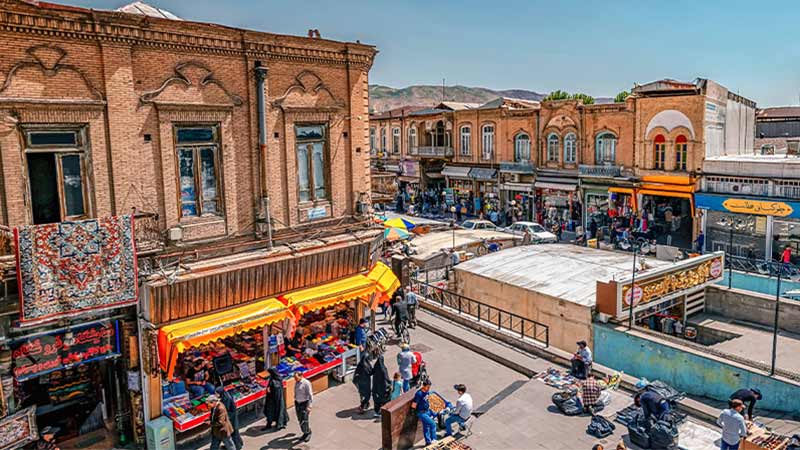
Azerbaijan Museum: After visiting the Tabriz Grand Bazaar, stop by the Azerbaijan Museum, Iran’s second most important archaeological museum. It houses an exceptional collection of historical coins, a library with 3,000 books, and various artistic and conceptual sculptures.
Conclusion
In summary, Tabriz Grand Bazaar is not just a market but a vibrant piece of history in Iran. Its maze of shops, rich culture, and unique architecture make it a fascinating destination. If you found this article interesting or have visited Tabriz Grand Bazaar, feel free to share your experiences and memories in the comments section of this article.



